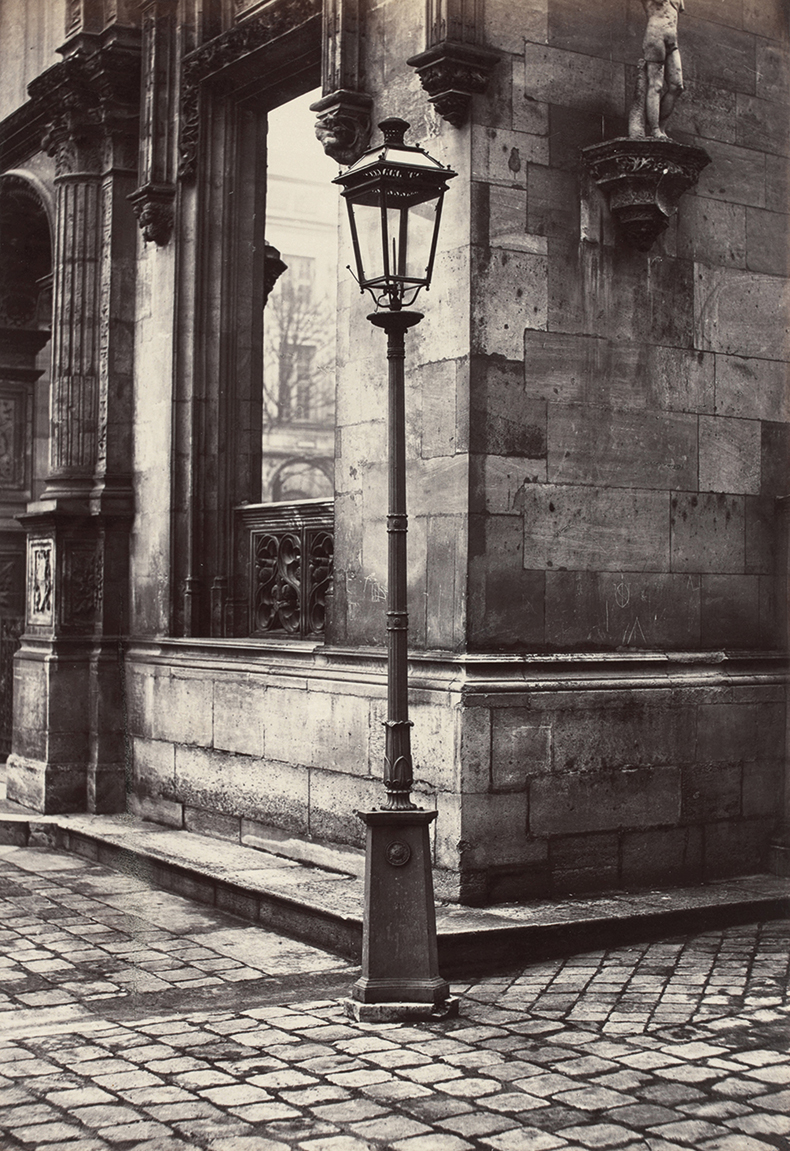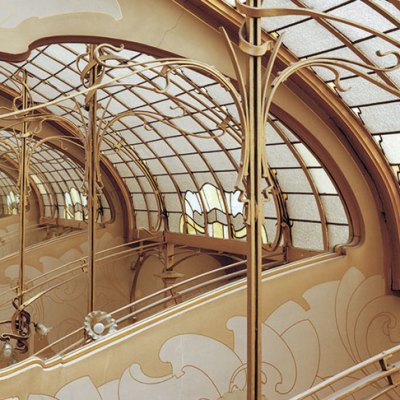From the January 2023 issue of Apollo. Preview and subscribe here.
When Baron Haussmann drove his new avenues through the old streets of Paris, smashing through the barricade-friendly cobbled medieval alleys and dingy courts, he also created a new layer of public infrastructure between the scale of the block and the body: an elaborate new set of street furniture.
The rebuilding of Paris was a moral as well as a political and aesthetic imperative, and moral aims certainly informed the new street furniture. Street lights were intended to deter streetwalkers and shady assignations in dark corners. Pissoirs and public lavatories represented an effort to create cleaner, more sanitary streets; news kiosks and colonnes Morris, the onion-domed advertising columns, became ways of reading the city, promoting literacy and new forms of cultural life. Charles Marville, the photographer commissioned to document the new Paris, also became the official portraitist of this new generation of street furniture, capturing elaborately cast street lights and kiosks as dignified public figures in the city. These photographs were then show around the world in expos to promote Paris as the modern metropolis par excellence.
Lamp post, entrance to the École des Beaux-Arts (c. 1870), Charles Marville. State Library of Victoria, Melbourne

The benches in squares and chairs in parks became the elements through which people interacted with public space, the physical interface between the city and the citizen. It didn’t always work out as intended. The pissoirs became centres of gay cruising, street lights did not deter soliciting – rather, they spotlit the offer – and the cobbles continued to be weaponised, in 1871 and again, a century later, in 1968. Paris didn’t invent street furniture, of course. There had been street lights for a thousand years (Baghdad had them during Europe’s Dark Ages) and the palazzos of Florence still display the public benches built into their rusticated bases. Bollards, those most robust survivors, were almost everywhere. But Parisian architects and engineers codified these objects into an urban language. All painted in a distinctive dark green, with occasional exotic forms and monsters cast into lamp bases and bench legs, the new street furniture became a way of branding the city, markers of municipal ambition.
This class of objects, so ubiquitous in the streetscape and yet now increasingly anachronistic (postboxes, phone booths, coal holes) stamped an identity on the public realm. Think of London’s vivid red post- and phone boxes, New York’s fire hydrants spraying water on a scorching day or its orange-and-white striped steam vents spewing hot fumes. Or think of Venice’s well-heads, often refashioned Roman capitals at the centres of small squares, or of the garishly illuminated vending machines of night-time back-street Seoul. These items come to define a public realm and our perceptions of it.
Street furniture quickly became big business. Saracen Foundry in Glasgow published a catalogue from which a whole city of iron could be assembled. In its pages you could find hybrid drinking fountains, horse troughs and street lights. There were street lights fit for the steps outside grand theatres and others for modest alleys. There were endless variations of exotic lavatories – underground, overground – whole prefabricated assemblies including the fittings. These items were shipped across the British Empire, and thousands still survive, from Auckland to Buenos Aires via Singapore. The excavation of the new avenues to build subway systems created more opportunities. London’s stations were often integrated into existing buildings, but in Budapest (the world’s second subway system), New York and Paris they were visible as street furniture, assemblages of iron railings, lights, signage and steps indicating the presence of an underground realm.
In Paris, Hector Guimard’s strange, organic designs for the Metro introduced an almost alien language of whiplash lines and flowing tendrils, suggesting a futuristic realm of the other. Guimard’s organic designs, dating from 1900, introduced a new language to the street, their fluid lines and vegetal forms in stark contrast to the Beaux-Arts solidity of the city blocks. Glass canopies radiating like daisy petals and red lights hanging like exotic fruit indicated a slightly sinister presence below, something strange, almost infernal, definitely new and exciting.
Colonne Morris (1933), Brassaï. Photo SCALA, Florence; © Estate of Brassaï – RMN-Grand Palais

Art nouveau may not have lasted long, but it left an indelible mark through these gateways. These eccentric excrescences, painted in that same Paris-municipal green, were conceived as a part of a coherent language of objects of public amenity. Paris’s mayor, Anne Hidalgo, who has done much to reimagine the city, from cycle infrastructure to the idea of the 15-minute city, suburban renewal and excellent public housing, has also sought to restore this layer of street furniture. The renewal reveals what has changed in the intervening century and a half. The pissoirs are long gone, replaced by prefab concrete superloos (a post-brutalist French design in corduroy concrete or textured steel). The colonnes Morris are now provided by JCDecaux to the city for free in exchange for a diet of bland, backlit global advertising. The elaborate street lights are mostly reproductions, faux Parisiana. The news kiosks are admittedly now far more comfortable for their vendors, well-heated and lit, but stripped of their Second Empire domes and elaborate cast-iron frills, they emit the banal light of contemporary corporate retail.
And Paris has the best of it. The decline elsewhere is dire. What was once considered a critical part of public amenity, and designed with that dignity in mind, is being squeezed by hordes of cheaply made, ill-considered communications boxes, 5G masts, anti-terror devices, surveillance cameras mounted on chunky poles and charging points. And almost all these features look terrible, having the effect of cluttering the pavement and making the city a little meaner and bleaker. There are a few chinks of light: the combination of truck-bomb-stopping planters and the kind of parklets that became popular during Covid-era pedestrianisations has introduced a new layer of seating and occasionally greenery. The golden age of street furniture is over, unless we press for this new and growing generation of things to be amenities rather than obstacles. In the meantime, however, there is plenty from previous ages that continues to intrigue and delight. If only we’d notice it.
From the January 2023 issue of Apollo. Preview and subscribe here.


